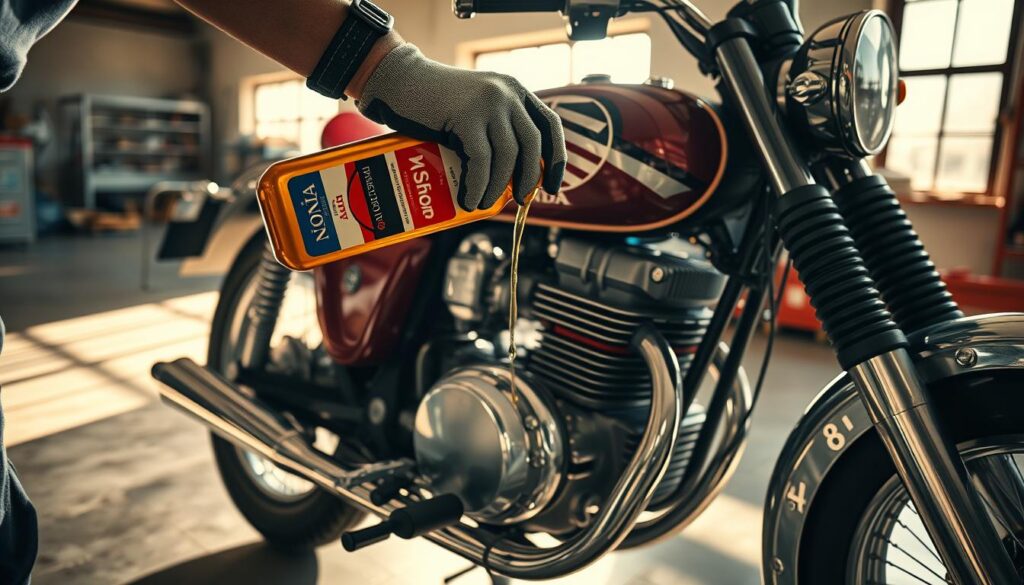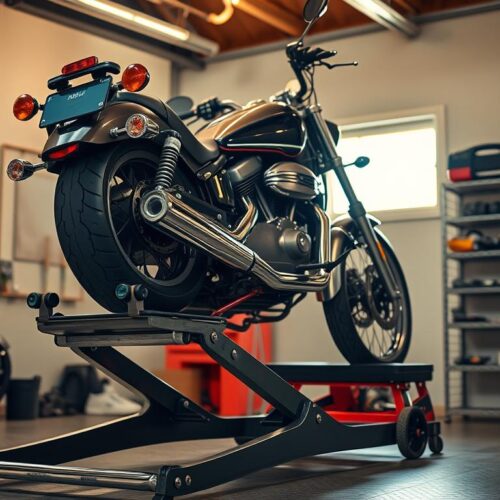Changing your motorcycle’s oil is key to keeping your bike running well. It helps the engine last longer and ensures top performance. This guide is designed for beginners. It shows you how to change your motorcycle’s oil easily and confidently. With the correct tools and information, you can do this important maintenance task yourself. This will help keep your motorcycle in excellent shape.
Why Regular Oil Changes are Crucial for Your Motorcycle
Getting regular oil changes is key to keeping your motorcycle running well. Over time, oil gets dirty and can’t lubricate the engine right. This causes more friction, making your bike use more fuel and risk breaking down.
Using fresh oil helps stop your bike from getting too hot. It keeps the engine working smoothly, so your ride lasts longer and performs better. If you skip oil changes, dirt builds up and can damage your engine badly.
It’s important to change your oil as the bike’s maker says. If you ride a lot, especially under tough conditions, you might need to do it more often. Regular oil changes mean your bike uses less fuel and rides better.
Tools and Supplies Needed for an Oil Change
To perform an efficient oil change, you will need the right oil change tools and supplies. Having these items ready will make the process smoother and quicker. Key tools for a motorcycle oil change include:
- Funnel: Helps in pouring new oil without spills.
- Oil catch pan: Collects the used oil during the draining process.
- Gloves: Protects your hands from oil and dirt.
- Oil filter wrench: Essential for removing the old oil filter.
- Socket wrench: Useful for loosening and tightening bolts.
- Torque wrench: Ensures bolts are tightened to the manufacturer’s specifications.
It’s also important to have the right type of engine oil and oil filter as your motorcycle’s manual suggests. With the correct tools, completing an oil change is easy and keeps your motorcycle running well.
Preparing Your Motorcycle for the Oil Change
Getting ready for an oil change is key to doing it right. Start by warming up your bike’s engine for a few minutes. This makes the oil thinner, which helps it drain out easily. After the engine is warm, park your bike on flat ground to keep oil from spilling.
Then, collect all the items you’ll need like new oil, a fresh oil filter, wrenches, and an oil catch pan. Put the catch pan under the drain plug to catch old oil and keep things clean. If necessary, take off any parts of the bike that are in the way of the oil filter and drain plug.
These prep steps are crucial for a smooth oil change. Having everything ready and within reach makes the process quicker and easier.
How to Drain Old Oil from Your Motorcycle
Draining old oil from your motorcycle keeps the engine running smoothly. First, make sure your motorcycle is off and has cooled down. This is very important for your safety. To help the oil drain better, remove the oil cap from the engine for air flow.
Then, find the right tool to unscrew the drain bolt at the oil pan’s bottom. Have a catch pan ready under it. When you take out the bolt, old oil will start flowing into the pan. Let it all drain out to take away any dirt.
After all the oil is out, put the drain plug back in tightly to stop leaks. Make sure the drain bolt is sealed well when you’re done draining the oil. Lastly, throw away the old oil the right way. Follow local rules on how to dispose of used oil to help protect our planet.
Installing the New Oil Filter
Installing a new oil filter is crucial for your motorcycle’s upkeep. Begin by removing the old filter with an oil filter wrench. Watch out for any oil spills during this process. It’s important to avoid making a mess.
Clean the mounting surface once the old filter is off. Leftover oil or debris may cause leaks. Then, get your new filter ready. Smear a little new oil on the filter’s rubber gasket. This helps create a good seal and makes installation easier.
Now, put in the new oil filter. Tighten it by hand, using the guidelines from the maker. Be careful not to overtighten it as it may cause damage. Properly replacing your motorcycle’s oil filter boosts its performance and longevity.
Adding Fresh Oil to Your Motorcycle
Adding fresh oil helps keep your motorcycle running smoothly. Start by checking your motorcycle’s owner’s manual for the right oil type and how much to use. With a clean funnel, pour the fresh oil into the fill port. This stops spills and keeps your engine safe.
It’s important to use the amount of oil your manual suggests. Once you’ve added the oil, put the oil cap back on tightly to avoid leaks. Then, turn on the engine for a few minutes. This helps spread the oil inside the engine and lets you check for leaks.

Checking for Leaks After an Oil Change
After you change your oil, it’s crucial to check for leaks. Start by looking at the drain plug and oil filter for fresh oil. This helps find leaks that might mean they’re not sealed right.
Then, let your engine run for a bit. While it’s running, watch the oil filter and drain plug areas closely. This step is key to make sure there aren’t any leaks. It tells you your oil change went well and your motorcycle is ready to go.
If you see any leaks, make sure everything is screwed on tight. Double-checking after you change the oil can save your engine and keep your motorcycle running longer.
| Inspection Area | Signs of Leaks | Action Required |
|---|---|---|
| Drain Plug | Fresh oil pooling | Tighten the drain plug |
| Oil Filter | Oil seeping around the filter | Ensure the filter is properly secured |
| Engine Area | Visible oil streaks | Inspect nearby connections and seals |
Maintaining Your Motorcycle After an Oil Change
After changing your motorcycle’s oil, it’s crucial to keep up with maintenance for the best performance. Make sure to check your oil levels often, so they’re just right. Also, look at the oil’s color and thickness because changes might mean there’s a problem. It’s important to check other parts like the air filter and spark plugs too. Doing this helps your engine run smoothly.
Here are some tips for your maintenance routine:
- Inspect the oil level weekly for any drastic changes.
- Check the oil’s appearance for signs of contamination.
- Ensure the air filter is clean and free from debris.
- Look for any leaks around the oil filter and drain plug after every ride.
- Examine other fluids, such as coolant and brake fluid, to ensure they are at appropriate levels.
Turning these checks into a routine will help your motorcycle last longer and be more dependable. Set specific times for regular checks. This way, you can find problems early and avoid expensive fixes.
Troubleshooting Common Oil Change Issues
When you change oil, you might face some problems. Knowing about these issues makes maintenance easier. Over-tightening the drain plug is a common mistake. It can destroy the threads, leading to expensive fixes. Always follow the correct torque specifications to prevent this.
Getting the oil level wrong is another issue. Too much or too little oil can harm your engine. Always check your motorcycle’s manual for the right oil amount. Use a dipstick to double-check.
Oil leaks might happen after you change the oil. This usually comes from a filter or drain plug that’s not put in right. Make sure to check for leaks regularly and tighten things as needed. Using the wrong oil type or mixing brands can also cause problems with your engine. Make sure you know what your motorcycle needs to avoid these mistakes.
- Over-tightened drain plug
- Incorrect oil levels
- Oil leaks from poor installation
- Using wrong type or mixing oil brands
Understanding how to troubleshoot can help you fix problems when changing oil. With this knowledge, your motorcycle’s maintenance will get better.

Conclusion: Embracing Regular Maintenance for Longevity
Adding oil changes to your bike maintenance schedule is crucial. They boost your engine’s performance and life. Regular, clean oil keeps your engine healthy. It makes sure your motorcycle runs well.
Changing your oil often also keeps your bike in top shape. It stops harmful contaminants that can damage your engine. By doing this, you enjoy safer rides and the excitement of riding without worries.
If you’re new to riding, learning to maintain your bike is key. Regular oil changes keep your motorcycle running perfectly. They also teach you valuable skills for a better riding experience. Ride with ease, knowing you’ve done your best for your bike’s well-being.




